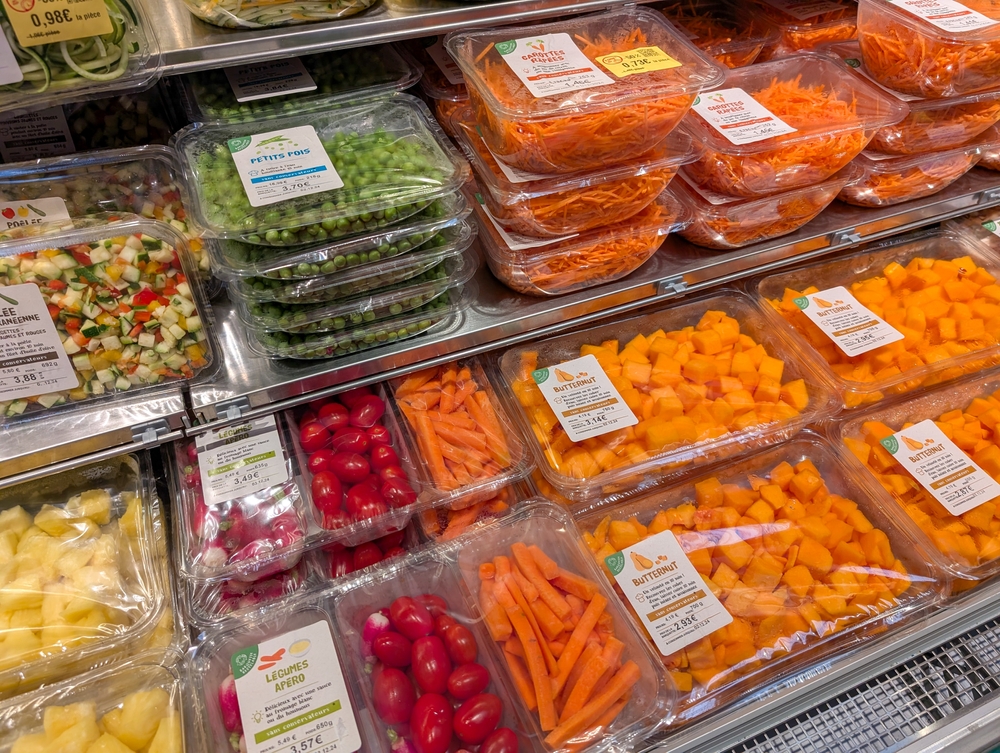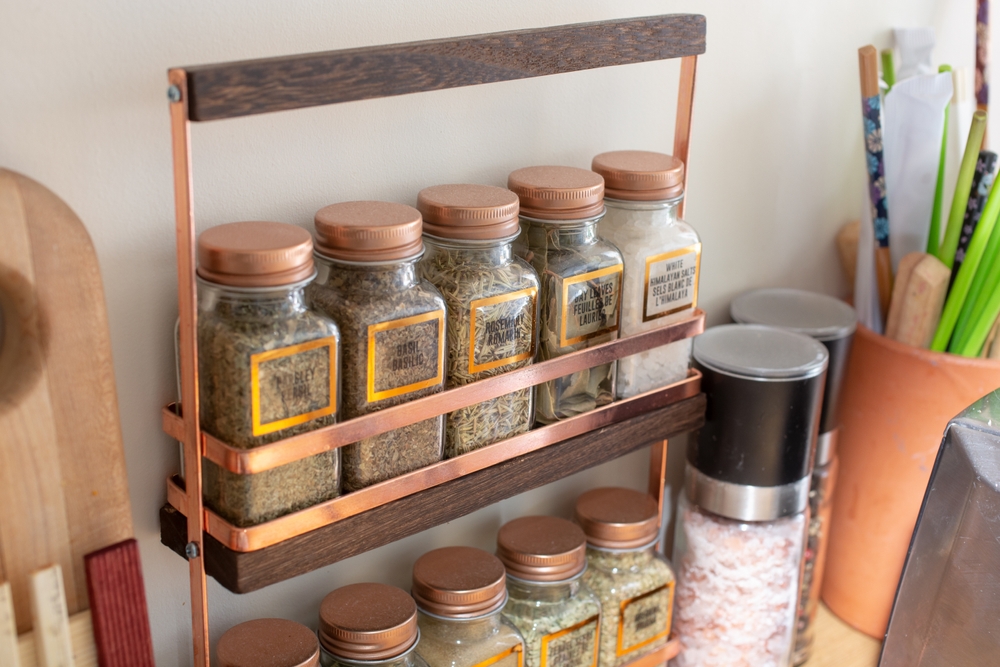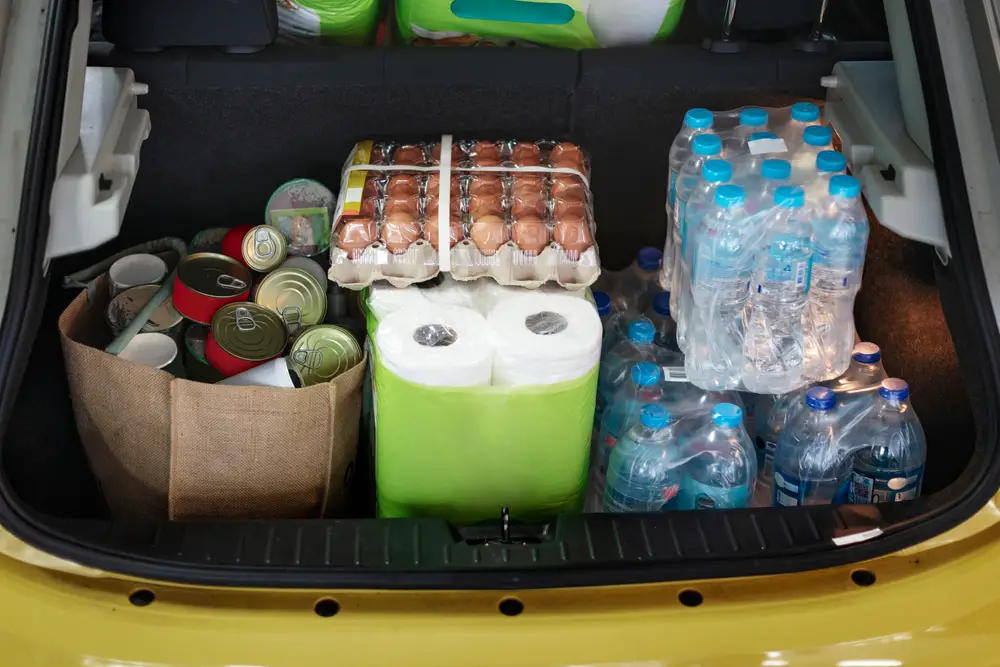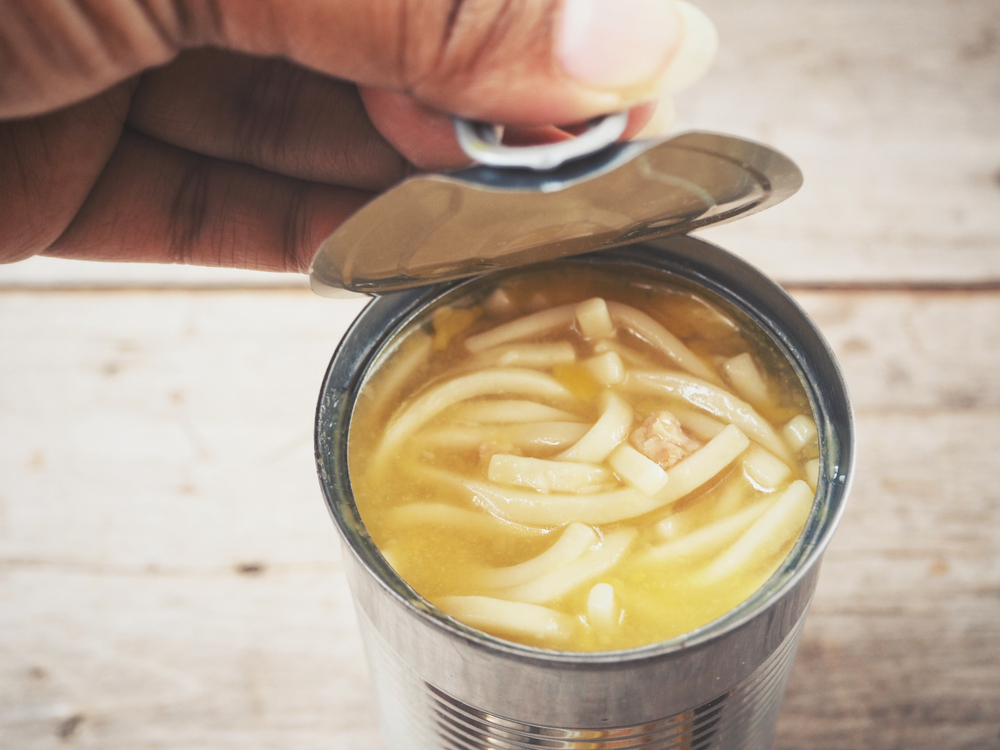You’re wandering the aisles of your local grocery store, confidently ticking items off your list. But are you truly getting the best bang for your buck? It turns out, certain grocery store staples are more hype than help, sucking up your cash while offering little in return. From fancy packaging to clever marketing, there’s often more cost than value behind some of these popular products. Here’s a round-up of 13 common grocery store buys that might be better left on the shelf.
1. Pre-Cut Fruits and Vegetables

Convenience is king, but it comes at a price. Pre-cut fruits and vegetables can cost up to three times more than their whole counterparts. Sure, they’re a time-saver, letting you skip the peeling and chopping, but that marked-up price tag adds up quickly. According to Consumer Reports, buying whole produce and spending a few extra minutes prepping it yourself can significantly cut down your grocery bill. Plus, whole fruits and vegetables tend to last longer, giving you more time to actually consume them before they spoil.
Besides the cost, there’s another downside to consider: freshness. Pre-cut produce often has a shorter shelf life, losing nutrients more rapidly once cut. This means you might be compromising on the quality of your food without realizing it. Additionally, pre-packaged versions can be more prone to contamination and bacteria exposure since they’ve been processed more than once. While the convenience is tempting, you might be better off sharpening your knife skills and opting for whole fruits and veggies.
2. Name-Brand Spices

Spices are essential for transforming basic meals into something special, but name-brand options can quickly empty your wallet. These tiny bottles often come with a hefty price tag, even though the contents are usually no different than their generic counterparts. Generic brands are often sourced from the same suppliers, meaning you’re paying more for the fancy label rather than higher quality. By opting for store-brand spices, you can save a substantial amount of money in the long run. Not to mention, spices have a long shelf life, so buying in bulk or larger quantities can be even more economical.
Consider this: most spices have a similar flavor profile regardless of the brand. The quality difference, if any, is typically so negligible that it won’t affect your home-cooked meals. Besides, spices lose their potency over time, so buying smaller, less expensive quantities ensures you’re using them at their freshest. Another cost-saving tip is to visit bulk food stores, which let you purchase only what you need at a fraction of the cost. Your pantry and your wallet will thank you for making the switch.
3. Bottled Water

Bottled water is marketed as the pinnacle of purity and health, yet it’s often just plain tap water in a fancier package. According to the Environmental Working Group, nearly half of all bottled water is derived from municipal sources. This means you’re paying a premium for what you could essentially get at home for free. Not only is this an unnecessary expense, but it’s also environmentally unfriendly, contributing to plastic waste. Investing in a reusable water bottle and a quality home filter can reduce both your expenses and your carbon footprint.
Beyond cost and environmental impact, bottled water doesn’t always guarantee better health. In fact, some bottled waters may contain more impurities than treated tap water. This is because tap water in many regions is subject to stricter regulations than bottled varieties. So the next time you’re tempted to toss a pack of bottled water into your cart, remember that you’re paying for the convenience and not necessarily an improvement in quality. Going the refillable route is not only more economical but also a healthier choice for both you and the planet.
4. Gourmet Salts

Gourmet salts have made a splash in culinary circles, promising enhanced flavors and exotic origins. They come in various colors and textures, each claiming to offer something unique. However, when it comes down to it, salt is salt, and the differences are often more about aesthetics than taste. What you’re really paying for is the fancy packaging and the allure of exclusivity. While these salts can add a nice touch as a finishing element, they aren’t necessary for everyday cooking.
Switching to regular sea salt or kosher salt could help manage your grocery expenses better. These alternatives are just as effective for seasoning and can be used in larger quantities without breaking the bank. Furthermore, the trace minerals found in gourmet salts can also be found in a balanced diet, meaning you’re not missing out on any significant health benefits. If you still wish to indulge occasionally, keep your gourmet salt as a special treat rather than a pantry staple. This way, you can enjoy the luxury without the guilt of overspending.
5. Pre-Made Smoothies

Pre-made smoothies may seem like a healthy grab-and-go option, but they’re often loaded with hidden sugars and calories. According to a report by the American Heart Association, many of these smoothies contain more sugar than a can of soda. While they market themselves as nutrient-packed beverages, the truth is they can be more of a dessert than a wholesome snack. Making smoothies at home allows you to control the ingredients and portion sizes, ensuring a healthier and more budget-friendly option. With just a blender and some fresh or frozen produce, you can whip up a smoothie that’s both delicious and nutritious.
Moreover, the cost of pre-made smoothies can quickly add up, especially if you’re consuming them regularly. A single serving can be as costly as buying all the ingredients needed to make several smoothies at home. By purchasing fruits and vegetables in bulk, you can stretch your dollar further and have the freedom to experiment with different flavor combinations. Not to mention, homemade smoothies can be stored in the freezer, ready to enjoy whenever you need a quick meal or snack. Making this switch not only benefits your wallet but also lets you enjoy the freshest, most flavorful smoothies possible.
6. Single-Serve Coffee Pods

Single-serve coffee pods have revolutionized the way people enjoy their morning brew, but they come at a steep price. The convenience of popping a pod into your machine is undeniable, but per serving, they cost significantly more than ground coffee. Over time, this daily habit can take a bigger chunk out of your budget than you might expect. Making the switch to a traditional coffee maker or a French press can save you money without sacrificing quality or flavor. You’ll also have more freedom to explore different bean varieties and roasts, enhancing your coffee experience.
Beyond cost, there’s the issue of waste to consider. Single-serve pods contribute to environmental pollution, with the majority ending up in landfills. Opting for a reusable filter or compostable pod options can help mitigate this issue while still allowing for a convenient coffee experience. Additionally, brewing your own coffee gives you more control over strength and taste, leading to a more personalized cup. While the allure of single-serve pods is strong, the potential savings and environmental benefits of traditional coffee methods are worth contemplating.
7. Boxed Granola

Granola is often touted as a health food, but boxed varieties can be surprisingly deceptive. According to a study by the Harvard School of Public Health, many contain excess sugar and unhealthy fats that negate their nutritional benefits. While the packaging might boast whole grains and nuts, it’s important to read the fine print for hidden ingredients. Making your own granola at home lets you control sweetness, fat content, and portion sizes, ensuring a healthier snack. Plus, homemade granola can be tailored to your taste and dietary preferences, making it far superior to its store-bought counterpart.
Cost is another factor that makes boxed granola a less-than-ideal purchase. Pre-packaged options tend to be pricey, especially when compared to the cost of buying oats, nuts, and dried fruits in bulk. With a bit of time and creativity, you can whip up batches of granola for a fraction of the store price. Additionally, homemade granola has the advantage of being free from preservatives and artificial flavors. This not only enhances the nutritional value but also offers a fresher taste that’s hard to beat. Once you start making granola at home, you might never go back to the boxed version again.
8. Packaged Salads

Packaged salads might seem like a healthy, convenient meal option, but they often come with hidden drawbacks. These ready-to-eat meals usually contain preservatives to extend shelf life, which can alter the taste and texture of the greens. Additionally, pre-packaged salads tend to be significantly more expensive than buying the components separately and assembling them yourself. The cost of convenience can add up, particularly if you’re purchasing these salads regularly. By buying whole lettuce or greens and adding your own toppings and dressing, you’ll enjoy fresher flavors and potentially save money.
Another issue with packaged salads is the risk of contamination. Since they’re handled and processed more extensively, there is a higher chance of bacterial exposure. Washing and preparing your own salad ingredients minimizes this risk, allowing you to ensure each component is clean and fresh. It also affords you the freedom to customize your salad with a wider variety of ingredients, enhancing both nutrition and taste. So while the allure of a quick meal is tempting, making your own salad could be both a healthier and more economical choice.
9. Instant Oatmeal Packets

Instant oatmeal packets are a breakfast staple for many busy households, but they’re often loaded with added sugars and artificial flavors. While they offer convenience, these packets can cost significantly more per serving than buying oats in bulk. Preparing oatmeal from scratch doesn’t require much more effort and allows you to control the ingredients, cutting out the unhealthy extras. Whole oats are also more versatile, letting you experiment with toppings and preparation methods to suit your taste. By opting for bulk oats and adding your own flavorings, you can enjoy a healthier, more satisfying breakfast.
Furthermore, instant oatmeal packets often skimp on portion size, leaving you hungry shortly after eating. Making your own oatmeal allows you to adjust serving sizes to meet your nutritional needs, ensuring a more filling meal. This also provides the opportunity to add nutrient-rich toppings like nuts, seeds, and fresh fruits, further enhancing the meal’s health benefits. In the long run, transitioning to whole oats can be both a cost-effective and healthier choice for your morning routine. Your taste buds and your budget will likely thank you for making the switch.
10. Canned Soups

Canned soups are a pantry staple, marketed as a quick and easy meal option. However, many of these soups are high in sodium and preservatives, which can detract from their nutritional value. Additionally, the cost of canned soups tends to be higher compared to making a batch of homemade soup with fresh ingredients. Not to mention, the flavors of canned options can be lackluster, lacking the depth and richness of a homemade version. By making soup from scratch, you can enjoy a healthier meal, tailored exactly to your taste preferences.
Another benefit of homemade soup is the ability to control portion sizes, reducing waste and allowing for better meal planning. Once you’ve prepared a batch, it can be portioned out and frozen for future meals, making it a convenient choice similar to canned soup. This approach not only saves money but also ensures you’re consuming a meal that’s free from unnecessary additives. Furthermore, making soup at home allows for a wider variety of ingredients, boosting both nutritional content and flavor. While canned soups offer convenience, the advantages of homemade soups make them a worthy alternative to consider.
11. Flavored Yogurt

Flavored yogurt is an appealing snack choice but often contains added sugars and artificial ingredients. These extras can turn a healthy option into more of a dessert, negating some of the yogurt’s nutritional benefits. Plain yogurt, on the other hand, provides all the essential nutrients without the unnecessary extras, allowing you to sweeten it naturally. You can add fresh fruits, nuts, or a drizzle of honey to enhance the taste and nutritional content. By choosing plain yogurt and adding your flavors, you’ll enjoy a healthier, more satisfying snack that’s often cheaper than pre-flavored versions.
Beyond its nutritional drawbacks, flavored yogurt can be more expensive than its plain counterpart. The cost of added flavors and packaging can add up, making this a less economical choice over time. By purchasing a larger container of plain yogurt, you’ll not only save money but also reduce packaging waste. Additionally, this approach allows you to experiment with different flavor combinations, providing variety in your diet. Making the switch to plain yogurt with your own toppings can improve both your health and your budget in the long run.
12. Pre-Packaged Sandwiches

Pre-packaged sandwiches are a convenient grab-and-go option, but they often come with a hefty price tag. The cost is significantly higher than making a sandwich at home, where you can control both quality and quantity of the ingredients. Additionally, these sandwiches tend to have a higher sodium content and often contain preservatives to maintain freshness. By preparing sandwiches at home, you can tailor them to your taste while ensuring fresher and healthier ingredients. This not only benefits your wallet but also provides a more satisfying and nutritious meal.
Another disadvantage of pre-packaged sandwiches is the lack of variety they offer. The limited selection can become monotonous, especially if you rely on them frequently. Making sandwiches at home allows for greater creativity, enabling you to try different bread types, fillings, and condiments. This flexibility not only keeps meals interesting but also allows for better meal customization to suit dietary preferences. Opting for homemade sandwiches over pre-packaged ones is a simple yet effective way to improve both your diet and your spending habits.
13. Organic Packaged Goods

The organic label is enticing, often associated with health and sustainability. However, when it comes to packaged goods like snacks and cereals, the organic version can be significantly more expensive without offering substantial health benefits. While organic farming practices are beneficial for the environment, the nutritional content of organic packaged goods is often comparable to their non-organic counterparts. It’s essential to scrutinize the ingredients list and nutritional information rather than relying solely on the organic label. By focusing on whole, unprocessed organic foods and being selective with packaged items, you can support sustainable practices without overspending.
Moreover, the markup on organic packaged goods can be substantial, impacting your overall grocery budget. For many, this higher cost isn’t justifiable, especially if the health benefits are minimal. Opting for non-organic versions of certain packaged goods can free up funds to invest in organic produce or meats, where the impact is more significant. This balanced approach allows for a more sustainable and health-conscious shopping experience. By being discerning about where and how you spend your organic dollars, you can make choices that benefit both your health and the environment.
This article is for informational purposes only and should not be construed as financial advice. Consult a financial professional before making investment or other financial decisions. The author and publisher make no warranties of any kind.








